Jane Grigson's Chocolate pie - a lucky dip
- rosemary
- Dec 7, 2021
- 7 min read
"Chocolate pie chocolate pie! This is the best thing he’s made so far hands down. Dark chocolate, cream, booze, icing sugar, sugar, almonds, it’s all your favourite things in one giant ganache of nauseating lurve."
Greg - Neil Cooks Grigson

This picture is not actually of Jane Grigson's version of Chocolate pie, but I think, other than the crust, it is pretty close. I do actually have a couple of photographs of the actual dish, but they are 'amateur' and don't look quite so amazing. Well I want you all to read my posts, so I have to try and suck you in with pretty pictures.
So just for information here are the others. The one on the left is from Neil Buttery - the man behind Neil Cooks Grigson - which I shall come to shortly, and the other two are from the author of Briny Life's version of a Two Fat Ladies recipe, which when I look at it is a direct crib of Jane Grigson's, although they seem to have omitted the rum flavoured cream on top.
The recipe comes from Jane Grigson's English Food and it features in the Puddings section, which in this case, doesn't mean pudding in the sense that you are probably thinking of, but in the sense of 'dessert'. For this is a tart. Although I suppose the Americans seem to call tarts pies, which is very confusing. And i've even seen this particular dish described as Chocolate pudding pie! I think I've said before that Jane Grigson is the queen of tarts. She has a tart for everything and they are all good. I have never actually tried this one, but maybe I should - well next time I have chocolate lovers to dinner. Very rich though, and the pastry is very unusual - just ground almonds, mixed with sugar and egg whites. That part of the recipe is from Hannah Glasse who wrote her cookbook The Art of Cooking, Made Plain and Easy back in 1747. The filling is from another eighteenth century food writer John Farley - The London Art of Cookery 1783. The two recipes were then combined by Michael Smith in his book Fine English Cookery (1973) and Jane Grigson got it from there. His book:
"starts from the reasonable assumption that people who sat on Chippendale chairs in elegant houses, were unlikely to be eating filthy food from their Wedgwood dinner services. Therefore what they ate is worth exploring." Jane Grigson
I don't know whether Jane Grigson adapted it yet further, but here is the recipe - complete with her comments which demonstrate very nicely the style of her writing.

CHOCOLATE PIE
for 6-8
6oz almonds, blanched, ground
2 oz caster sugar
1 egg white
Filling
1/2 pint single cream 1/2 lb plain chocolate, preferably Menier, Velma Suchard or Côte d'or
1/2 pint double cream
1 tablespoon rum
1 tablespoon icing sugar
Chocolate flakes, toasted almonds
This is one recipe for a tart which must be eaten the day it is made: if you keep it, the crackling crust becomes tough. It is also a good idea to delay putting in the chocolate filling until a couple of hours before the meal.
Mix the crust ingredients to a stiff paste. Chill it for half an hour, and then roll it out on a lightly floured board. Fit it into an 8"-9" flan tin. The crust is likely to break, unlike pastry, but don't worry - just press the pieces gently together in the tin to close the joins. Bake blind for 25-20 minutes at mark 4, 350ºF. The crust should be as golden brown as possible without scorch marks.
To make the filling, stir the single cream and chocolate, broken into pieces, in a double boiler until they are melted into a smooth sauce. Cool it quickly, then whisk until the sauce froths into a foamy bulk. Pour it into the cooled crust. Decorate with the double cream, whipped with the rum and icing sugar, and with the chocolate flakes and toasted almonds.
The pie does not cut easily into tidy pieces, but it tastes so good that you need not be apologetic.
On Neil Buttery's website Neil Cooks Grigson he (and his partner Greg) add a few extra remarks but interestingly he doesn't have the recipe.
#7 Chocolate pie - If I wasn’t following the recipes exactly, I would have missed out the rum – I’m not a fan of spirits in sweets. I’m glad I did though – I used dark rum (she didn’t say which type to use) and it was absolutely gorgeous! It was the richest dessert I think I’ve ever had. I’m writing this 4 days after making and eating it and I still feel pleasantly nauseous. My tastes are obviously changing; think I’ll put alcohol in everything. Gin and apple crumble or sambuca trifle anyone!?
Here’s what Greg says:
Despite what the book says about eat within one hour, we had some the next day and it had settled into a firmer lush cheesecake-like texture and was divine so don’t feel duty-bound to wolf the whole thing at once, not that you could, it’s VERY rich. Sounds fairly easy to make but looks so impressive ... Yummmm. 5/5." Neil Cooks Grigson
And just to note, one of those other websites mentioned that it was very tricky to roll out the pastry - if you can call it that - for the shell, and that it was much better to press it into place.

But who is Neil? Neil is Neil Buttery, a Mancunian, who is now a chef, food writer, and general foodie, with various ventures on the go including podcasts. His blog Neil Cooks Grigson, was begun way back in 2007 whilst he was doing a PhD. Along the way I think he changed careers - food which began as a hobby has now become his main interest/career, specifically with reference to British food, the social aspects and its history.. The aim with Neil Cooks Grigson was to cook his way through Jane Grigson's English Food, partly inspired I think by Julie and Julia. I suspect many of us have had the same idea.

As you can see it's a fairly plain website, and there are not many sections to it - well none really although there is a tag cloud and a search option. But it's a WordPress site, and that means it's a bit ordinary in layout and a little bit difficult to find things. I tried WordPress myself when I was investigating websites way back for my film society, but was distinctly unimpressed. But in this case it's worth persevering because the content is worth reading.
I myself, at one point, decided I would cook my way through Robert Carrier's Great Dishes of the World, but, of course, I didn't get very far. Instead I diverted to setting up and writing this blog. I think that was partly because there were various recipes in Robert Carrier's book that, frankly, I did not fancy making, or that David wouldn't have eaten and so it was set aside. The same would have been the case for any cookbook I hasten to add. I mean any chapter on seafood (not fish) is a no no for a start. It was just a written thing too which was much less creative in a weird kind of way.

Neil Buttery however, has stuck at it. He is now up to recipe #444, Poached turbot with shrimp sauce although I think there are still a couple of hundred of recipes to go - I vaguely remember reading somewhere on his blog that there are around 600 recipes in the book. Yes he is still working on it, but seems to have recently finished a chapter - Salt-water fish. Not that he methodically works through every chapter.

His very first recipe was also a fishy one - Finnan Haddock Soup, shown here on the left. A slightly odd choice with which to begin. Yes it's in the first chapter on Soups, but it's not the first recipe. But then again, why not start there?
As I said, I myself, got diverted from my nascent Robert Carrier project to this blog, and Neil Buttery, became so interested in English food that he has also set up another blog called British Food: a history. This was begun in 2011 when he was working in America with this aim:
"I want to add the recipes Jane Grigson didn’t use, I want to add the best of the ones I have cooked from the book, more importantly I want to look more at Wales and Scotland. Not just that, but to extend the map to the other countries that have had links with my own – for better, or for worse – like Ireland, France, India and the countless other countries too that have moulded our people, culture and food throughout history. I also want to go back in time to Britain before the Middle Ages too. What influence did the Roman occupation have, for example? What about further back to prehistory? How did farming come about in Britain and what did the foraging people eat before farming on any scale even occurred?
So, the blog will be a mix of recipes, findings and short essays on our amazingly rich, frequently odd and overwhelmingly dynamic the Britons have been – and still are – with their food."

I come across it every now and then when I am doing something about British food it's pretty comprehensive and also very interesting. The current topic is To Make a Christmas pudding: part 1 - Stir-up Sunday. An article that I obviously should have looked at when I did my recent post on Christmas pudding. Neil Cooks Grigson, has been a very useful source when I am doing something Jane Grigson related. For she is a star - Julian Barnes said something along the lines of not wanting to hear a word against her - even from him. Much more low key that Elizabeth David and Robert Carrier but very informative and I don't think I have ever had a failure with any of her recipes. And I've cooked heaps of them. She's perhaps more akin in approach to Claudia Roden than the other two. A bit more learned. She has written lots of books of course, and I don't have all of them, but I think I have most, and definitely the best ones. I should perhaps try and track down her book on fish. although we really don't eat a lot of fish.
Below is my somewhat battered copy of English Food. She first published it for Macmillan in 1974. I have the 1977 Penguin Edition - and it's falling apart and yellowing with age and use.

As for that chocolate pie - well I really ought to consider it next time I need to cook a dessert for somebody. Maybe I should try it with the grandchildren some time. It sounds pretty easy.
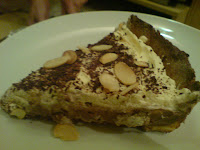
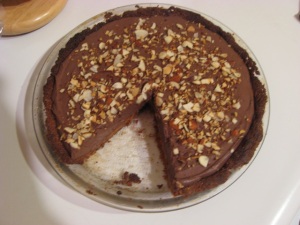
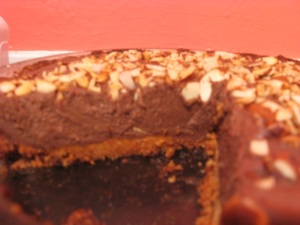
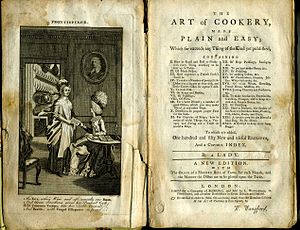




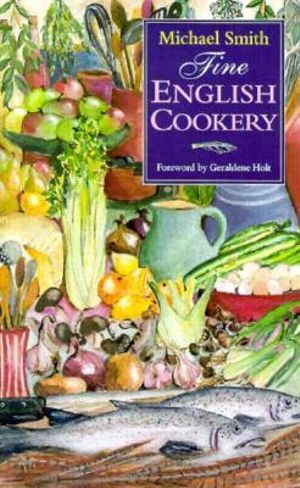



Comments